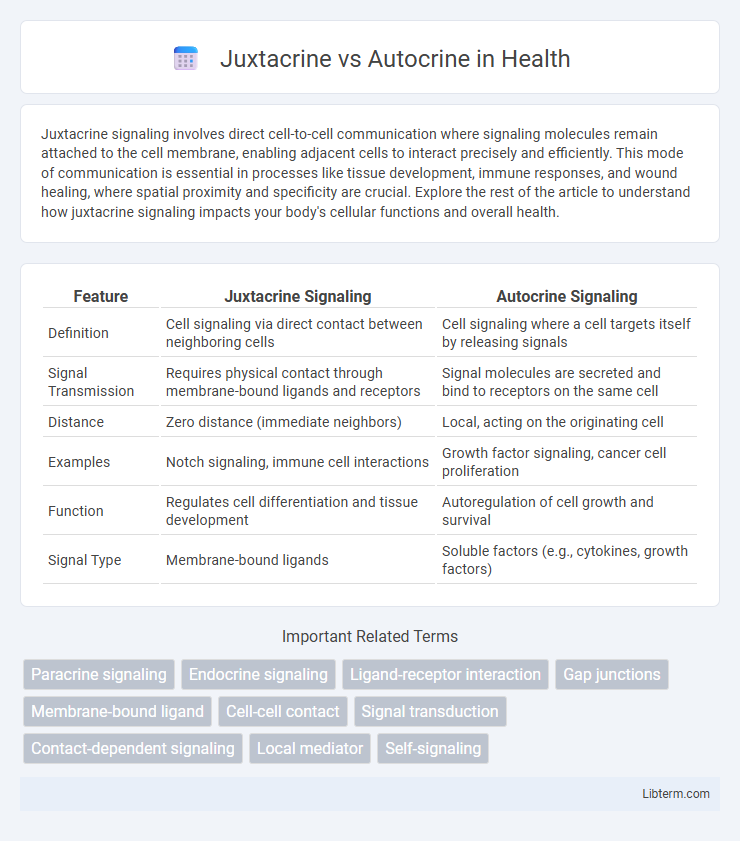Juxtacrine signaling involves direct cell-to-cell communication where signaling molecules remain attached to the cell membrane, enabling adjacent cells to interact precisely and efficiently. This mode of communication is essential in processes like tissue development, immune responses, and wound healing, where spatial proximity and specificity are crucial. Explore the rest of the article to understand how juxtacrine signaling impacts your body's cellular functions and overall health.
Table of Comparison
| Feature | Juxtacrine Signaling | Autocrine Signaling |
|---|---|---|
| Definition | Cell signaling via direct contact between neighboring cells | Cell signaling where a cell targets itself by releasing signals |
| Signal Transmission | Requires physical contact through membrane-bound ligands and receptors | Signal molecules are secreted and bind to receptors on the same cell |
| Distance | Zero distance (immediate neighbors) | Local, acting on the originating cell |
| Examples | Notch signaling, immune cell interactions | Growth factor signaling, cancer cell proliferation |
| Function | Regulates cell differentiation and tissue development | Autoregulation of cell growth and survival |
| Signal Type | Membrane-bound ligands | Soluble factors (e.g., cytokines, growth factors) |
Introduction to Cell Signaling Mechanisms
Juxtacrine signaling involves direct cell-to-cell contact where membrane-bound ligands bind to receptors on adjacent cells, enabling localized communication crucial for processes like immune responses and tissue development. Autocrine signaling occurs when cells release signaling molecules that bind to receptors on their own surface, allowing self-regulation of cell growth, differentiation, and survival. Both mechanisms exemplify distinct strategies in cell signaling pathways that coordinate cellular behavior and maintain tissue homeostasis.
Defining Juxtacrine Signaling
Juxtacrine signaling involves direct cell-to-cell communication through membrane-bound ligands and receptors, requiring physical contact between adjacent cells. This type of signaling plays a crucial role in processes such as immune responses, tissue development, and cell differentiation by enabling precise and localized interactions. Unlike autocrine signaling, which affects the signaling cell itself via secreted molecules, juxtacrine signaling strictly depends on the juxtaposition of cells for signal transmission.
Understanding Autocrine Signaling
Autocrine signaling involves a cell releasing signaling molecules that bind to receptors on its own surface, enabling self-regulation and feedback control. This mechanism plays a crucial role in processes like immune response, cancer progression, and tissue development by promoting cell survival and proliferation. Unlike juxtacrine signaling, which requires direct cell-to-cell contact, autocrine signaling operates independently within the releasing cell's microenvironment.
Key Differences Between Juxtacrine and Autocrine
Juxtacrine signaling requires direct physical contact between adjacent cells through membrane-bound ligands and receptors, enabling localized communication essential for processes like immune response and tissue development. Autocrine signaling involves a cell secreting signaling molecules that bind to receptors on its own surface, allowing self-regulation and feedback mechanisms critical in cell growth and differentiation. The primary difference lies in the spatial relationship: juxtacrine signaling operates via direct cell-to-cell contact, while autocrine signaling functions through secreted factors acting on the same cell.
Molecular Pathways Involved in Juxtacrine vs Autocrine
Juxtacrine signaling involves direct cell-to-cell contact where membrane-bound ligands on one cell interact with receptors on an adjacent cell, activating pathways such as the Notch signaling cascade crucial for cell differentiation. Autocrine signaling occurs when cells release signaling molecules like cytokines or growth factors that bind to receptors on their own surface, triggering intracellular pathways including the JAK/STAT and MAPK cascades to regulate cell growth and survival. These distinct molecular mechanisms highlight juxtacrine's reliance on physical contact for local effects, while autocrine signaling modulates cellular responses through self-secreted ligands impacting a cell's own receptor networks.
Physiological Roles of Juxtacrine Signaling
Juxtacrine signaling plays a critical role in maintaining tissue homeostasis by enabling direct cell-to-cell communication through membrane-bound ligands and receptors, which is essential for processes such as immune responses and embryonic development. This signaling modality allows cells to coordinate activities like differentiation and apoptosis in physically adjacent cells, ensuring precise spatial control of cellular functions. Juxtacrine interaction is vital in regulating stem cell niches and facilitating morphogenetic patterning during organogenesis, distinguishing it from the self-targeted feedback mechanism seen in autocrine signaling.
Biological Functions of Autocrine Signaling
Autocrine signaling plays a critical role in regulating cell proliferation, immune responses, and tissue repair by allowing cells to respond to signals they themselves produce, thus maintaining local control over cellular activities. This mode of communication is essential in cancer biology, as tumor cells exploit autocrine loops to promote uncontrolled growth and evade apoptosis. In contrast to juxtacrine signaling, which requires direct cell-to-cell contact, autocrine signaling operates through the secretion of signaling molecules that bind to receptors on the same cell, facilitating rapid and localized feedback mechanisms.
Examples of Juxtacrine and Autocrine in Human Biology
Juxtacrine signaling in human biology includes examples such as Notch signaling during embryonic development, where cell-to-cell contact is essential for differentiation. Autocrine signaling is exemplified by interleukin-2 (IL-2) production in activated T cells, which promotes their own proliferation and immune response. Both pathways are critical for cellular communication and maintaining physiological functions.
Clinical Implications: Juxtacrine vs Autocrine in Disease
Juxtacrine signaling, involving direct cell-to-cell contact, plays a critical role in tumor microenvironment interactions and immune cell activation, influencing cancer progression and metastasis. Autocrine signaling, where cells respond to their own secreted signals, is often implicated in cancer cell proliferation and resistance to therapies, contributing to tumor survival and growth. Targeting these pathways offers promising therapeutic strategies in diseases such as cancer and autoimmune disorders by disrupting aberrant cell communication.
Summary and Future Directions in Cell Communication Research
Juxtacrine signaling involves direct cell-to-cell contact through membrane-bound ligands and receptors, enabling precise and localized communication essential for tissue development and immune responses. Autocrine signaling, where cells release signaling molecules that bind to their own receptors, plays a critical role in regulating cell growth, differentiation, and survival. Future research in cell communication focuses on elucidating the complex molecular mechanisms of these signaling modes and leveraging advanced imaging and single-cell analysis technologies to develop targeted therapies for cancer, autoimmune diseases, and regenerative medicine.
Juxtacrine Infographic

 libterm.com
libterm.com